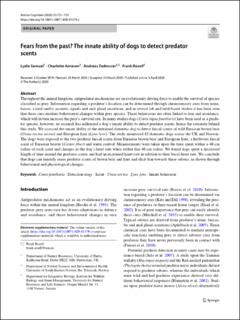| dc.contributor.author | Samuel, Lydia | |
| dc.contributor.author | Arnesen, Charlotte Holmstad | |
| dc.contributor.author | Zedrosser, Andreas | |
| dc.contributor.author | Rosell, Frank | |
| dc.date.accessioned | 2021-03-25T10:45:34Z | |
| dc.date.available | 2021-03-25T10:45:34Z | |
| dc.date.created | 2021-02-24T14:42:31Z | |
| dc.date.issued | 2020 | |
| dc.identifier.citation | Samuel, L., Arnesen, C., Zedrosser, A. & Rosell, F. (2020). Fears from the past? The innate ability of dogs to detect predator scents. Animal Cognition, 23(4), 721-729. | en_US |
| dc.identifier.issn | 1435-9448 | |
| dc.identifier.uri | https://hdl.handle.net/11250/2735489 | |
| dc.description.abstract | Throughout the animal kingdom, antipredator mechanisms are an evolutionary driving force to enable the survival of species classified as prey. Information regarding a predator’s location can be determined through chemosensory cues from urine, faeces, visual and/or acoustic signals and anal gland secretions; and in several lab and field-based studies it has been seen that these cues mediate behavioural changes within prey species. These behaviours are often linked to fear and avoidance, which will in turn increase the prey’s survival rate. In many studies dogs (Canis lupus familiaris) have been used as a predator species, however, no research has addressed a dog’s innate ability to detect predator scents, hence the rationale behind this study. We assessed the innate ability of the untrained domestic dog to detect faecal scents of wild Eurasian brown bear (Ursus arctos arctos) and European lynx (Lynx lynx). The study monitored 82 domestic dogs across the UK and Norway. The dogs were exposed to the two predator faecal scents from Eurasian brown bear and European lynx, a herbivore faecal scent of Eurasian beaver (Castor fiber) and water control. Measurements were taken upon the time spent within a 40 cm radius of each scent and changes in the dog’s heart rate when within this 40 cm radius. We found dogs spent a decreased length of time around the predator scents and had an increased heart rate in relation to their basal heart rate. We conclude that dogs can innately sense predator scents of brown bear and lynx and elicit fear towards these odours, as shown through behavioural and physiological changes. | en_US |
| dc.language.iso | eng | en_US |
| dc.rights | Navngivelse 4.0 Internasjonal | * |
| dc.rights.uri | http://creativecommons.org/licenses/by/4.0/deed.no | * |
| dc.title | Fears from the past? The innate ability of dogs to detect predator scents | en_US |
| dc.type | Peer reviewed | en_US |
| dc.type | Journal article | en_US |
| dc.description.version | publishedVersion | en_US |
| dc.rights.holder | © The Author(s) 2020. | en_US |
| dc.source.pagenumber | 721-729 | en_US |
| dc.source.volume | 23 | en_US |
| dc.source.journal | Animal Cognition | en_US |
| dc.source.issue | 4 | en_US |
| dc.identifier.doi | https://doi.org/10.1007/s10071-020-01379-y | |
| dc.identifier.cristin | 1893264 | |
| cristin.ispublished | true | |
| cristin.fulltext | original | |
| cristin.qualitycode | 1 | |

